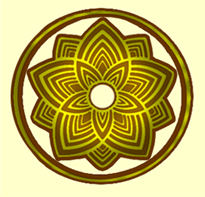

 |
 |
CHANTING PRACTICE |
|||||||||||||||||||||||||||||||||||||||
Glyphs that reflect patterns seen on the surface of flowing water are used to indicate the pitch of successive words, i.e. the melody of a Japanese style religious chant. The ‘Melodic Eko’ which can be seen on the SERVICE ORDER page on tis site is a good example. The same piece is also stored on the shinbuddhistfellowship.uk/dharmaarchive page. Each location also includes an mp3 audio clip of the chant. A reduced size copy of the same chant is shown herein as Fig 4. Mandarin has four distinct tones, and a neutral tone. A famous example is the four Mandarin words that are translated as ‘mother’, ‘fibre’, ‘horse’ and ‘scold’. They are pronounced in exactly the same way, but when tones are applied, they describe four different -and un-associated things.
Diacritical Marks: In phonetics (the study of speech sounds), a diacritical mark, a glyph—or symbol is added to a letter to alter its sense, function, tone and/or pronunciation.
The first four glyphs are identical; therefore, each are chanted in the same way. We should now note that the shape of this glyph is very similar to that shown as TONE 1 in Fig 2. The shape of the fifth glyph is likewise very similar to TONE 3 in Fig 2. It starts at the same pitch as the preceding four, then it dips, and then goes back up again.
The flowing water glyphs convey all the necessary information with a minimum of strokes, and with just a little practice one becomes able to simply ‘see it and sing it’. The glyph system is simple – and intuitive.
Fig 5 shows the correct western style notation for the four basic Mandarin linguistic tones (shown earlier as Fig 2). This simplified method involves a stroke-count of four; just one stroke for each of the four tones, yet it tells us all we need to know. Conversely, the western notation uses twenty-eight strokes to tell us more than we need to know! Before concluding, a few words regarding the lines that the two examples sit on (Fig 4). They each show symbols sitting on five lines. However, these lines differ range, and the two should not be confused. The Stave or Staff: Western notation sits upon what is known as a stave, or staff. Every line or space represents a white key on the piano. Appropriate music symbols are placed on the stave according to their corresponding pitch or function. Higher and lower notes may be added beneath and above the stave on extra ‘ledger lines’, if necessary. The singer Adele’s vocal range is about three and a half octaves. That’s more than 20 notes or tones. The average person’s range is no more than about 12 notes. However, traditional Japanese music is based on pentatonic (five tone) or heptatonic (seven tone) scales; and all these notes fit easily within the western stave. Ultimately, the only way we can fully appreciate the subtleties of any sound, be that as a solo voice or a symphony orchestra -is to hear it. If we listen to it over and over, we will learn it. And if we chant it out loud over and over, we will remember it. But a word of caution: If you cease your listening or chanting practice, it will fade from your memory. Finaly, we zoom out from the detail of individual strokes and examine the overall structure of a traditional Japanese folk song. So, in the hope that it helps deepen your appreciation of the structure of a Japanese religious chant, I augment this study with three exclusive audio clips. These clips are also featured on our new EXCLUSIVE AUDIO page.
|
|
|
|---|
| dgr@shinbuddhistfellowship.uk |
 |
| Rev Daichi Gary Robinson. SBFUK Office and Buddha Room 7 Lime Street, Southampton SO14 3DA. Phone or text: 0748 4861 094 |
 |